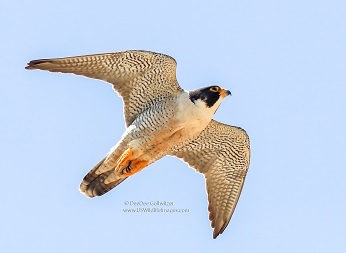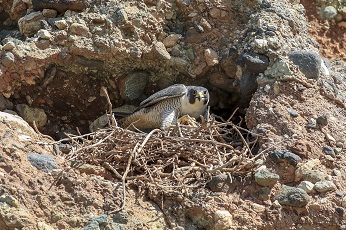Listing Status
 © DeeDee Gollwitzer, all rights reserved.
© DeeDee Gollwitzer, all rights reserved.
The peregrine falcon (Falco peregrinus) was listed as endangered in 1970 under the federal Endangered Species Act, and listed as endangered in 1971 under the California Endangered Species Act. Due to diligent conservation and recovery efforts, the species was federally delisted in 1999 and was delisted in California in 2009.
Distribution
The peregrine falcon is one of the most widely distributed raptors. Its full range(opens in new tab) extends from the tundra to the tropics and contains a wide range of habitats from wetlands, deserts, forests and islands. In California, breeding habitats include a variety of locations from cliffs in uninhabited areas to tall buildings or bridges within the urban landscape. Peale’s falcon (F. p. pealei) is a year-round resident of the Pacific Northwest, while the American peregrine falcon (F. p. anatum) occurs throughout much of North America from Alaska and Canada south to Mexico. Both subspecies can be found in California, with Peale’s falcons being more limited to the northern portion of the state.
Biology
 © DeeDee Gollwitzer, all rights reserved
© DeeDee Gollwitzer, all rights reserved
Peregrine falcons weigh 530-1600 grams with a wingspan of 39.4-43.3 inches (100-110 cm). The females are larger than the males but both sexes have similar plumage with long pointed wings and a long tail. Adults are blue-gray above and have light breast feathers, barred flanks and a dark head with thick sideburns, whereas juveniles more brownish overall and have heavy vertical streaks instead of horizontal bars on the breast. They are known as the fastest bird in the world, capable of reaching 150 to 200 mph in their dives and their average cruising speed is 24 to 33 mph and can increase to 67 mph when chasing prey.
Peregrines do not build nests like most other birds, instead they lay their eggs in a “scrape” or shallow indentations high a cliff side, or human-made structure, such as a building or bridge. Occasionally they will use old nests of other birds, such as ravens. The breeding season for peregrine falcons in California generally starts around late-February and early-March, and concludes after the young leave the nest between May and June; however, onset and completion of breeding can vary depending on a variety of factors.
Peregrines mostly prey typically prey on small to medium sized birds, such as songbirds, shorebirds, ducks, doves, and pigeons. Other prey taken includes small reptiles, mammals and occasionally bats.
History and Problems
Historically, peregrine falcons were once prevalent across North America and the rest of the world. Prior to World War II the breeding population in the United States was estimated at 3,875 pairs. In the early 1900s peregrine falcons experienced loss of habitat, were indiscriminately shot, their eggs were taken by egg collectors. The most impactful threat to the population was the widespread use of the pesticide DDT (dichlorodiphenyltrichloroethane). Shortly after World War II, DDT was used extensively to control mosquitoes and other insects. It was later determined that DDT and its metabolite DDE were poisoning peregrine falcons causing egg shell thinning that resulting in many failed nesting attempts. The widespread use of DDT also affected other species such as the Bald Eagle and Brown Pelican. By the mid-1960s there were no peregrine falcon in the eastern United States and populations were declining in the west. By 1970 the breeding pairs in had dropped by about 95%. By 1975 there were only about 324 known pairs in the United States.
Recovery Efforts
DDT was banned in the United States in 1972 due to its negative effects on wildlife species. With the help from various conservation partners (e.g., Santa Cruz Predatory Bird Research Group(opens in new tab), Institute for Wildlife Studies(opens in new tab), Peregrine Fund(opens in new tab), falconers, and other volunteers) state and federal wildlife agencies successfully implemented recovery projects for the peregrine falcon, including a breeding and reintroduction program. The population began to increase once again as a result.
Population Status and Trend
 © DeeDee Gollwitzer, all rights reserved
© DeeDee Gollwitzer, all rights reserved
As noted above, the peregrine falcon experienced steep declines throughout its range, including in California. Today, migration and breeding survey data in the western U.S. indicate an increasing population trend. This upward trend can largely be attributed to the effort of dedicated biologists and volunteers across the United States. Today, we have documented over 400 breeding pairs in California (see map of known territories (PDF)(opens in new tab)).
Submission of Peregrine Falcon Data
The California Department of Fish and Wildlife maintains a database on the annual status of all known breeding territories. Data are submitted annually by various partners using the Peregrine Falcon Nesting Territory Survey Form (PDF Form).
You may also submit peregrine falcon data using the CNDDB Online Field Survey Form. This form is an internet application that allows users to map an observation of a rare species, including but not limited to golden eagles, and submit the location and associated data in a single step. First time users will need to set up an account but will not need a CNDDB subscription to submit data.